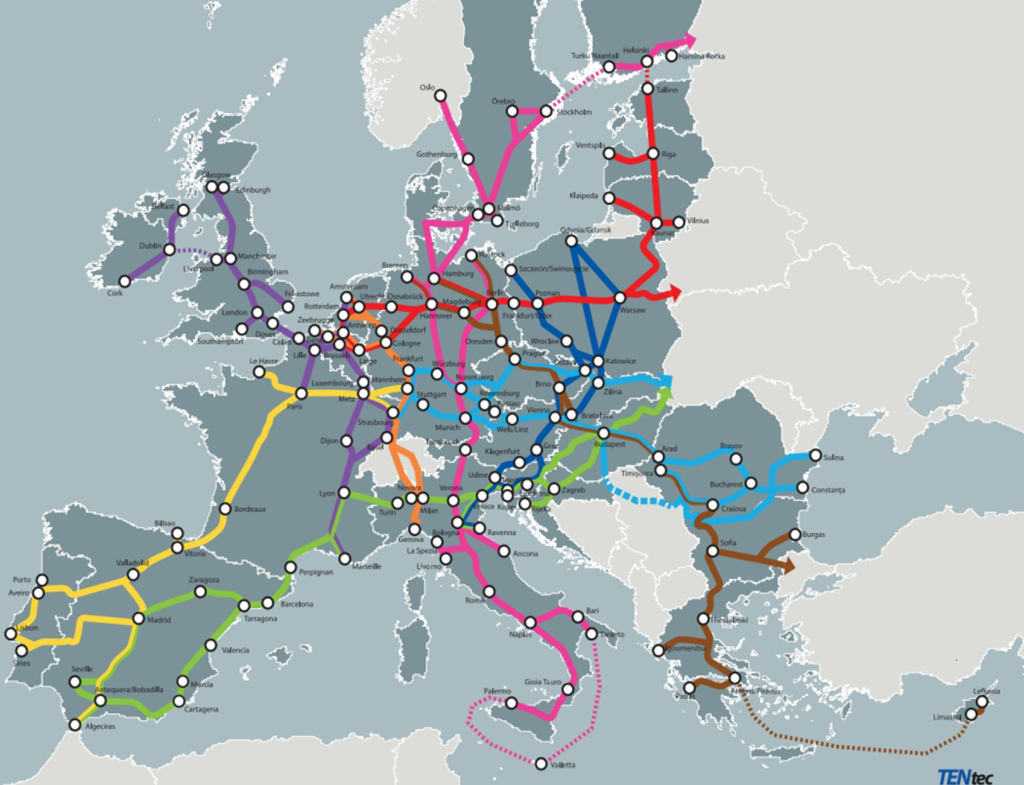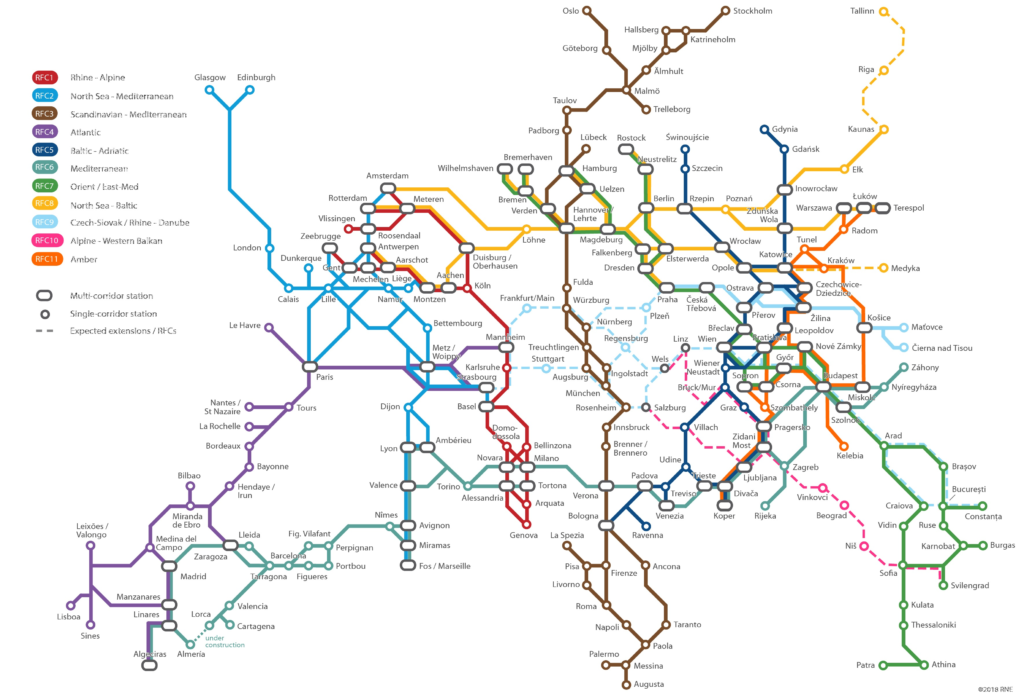Networks
Trans-European Transport Network (TEN-T) Rail Freight Corridors (RFC’s) Cross border – Contingency Management Cross Border – Issues LogbookTrans-European Transport Network (TEN-T)

Objective
The Trans-European Transport Network (TEN-T) is a set of rail, road, air and water transport networks in the European Union. They provide integrated and intermodal long-distance high-speed routes across the continent by taking away border obstacles and removing gaps in the network that hinder cross-border traffic. This ‘flagship’ project of the EU Transport Policy aims at developing European transport infrastructure to deliver a genuine Single European Transport Area (SERA).
The TEN-T network for rail (amongst other modes) is governed by Regulation (EU) No 1315/2013 on Union guidelines for the development of the trans-European transport network. TEN-T is divided into two layers:
- a core-network of routes which should be finished by 2030, and
- a comprehensive network which should be implemented by 2050.
EIM in action
- EIM supports the transport policies implementing the TEN-T legislation (including the ‘Smart TEN-T’ proposal) and advocates sufficient funding and support at European and national levels to achieve the TEN-T goals.
2020
- In 2020, the European Parliament and Council informally adopted a legislative proposal to streamline the permit-granting procedure for the development of infrastructure that is part of a TEN-T line (the so-called ‘Smart TEN-T proposal’). Since the launch of the legislative process, EIM has provided constant input to the EU institutions.
- EIM replied to the numerous assessment initiatives of the European Commission related to the potential revision of the TEN-T Guidelines. One of the core issues for EIM is the possible revision of TEN-T parameters for future railway infrastructure, as well as a better streamlining between the TEN-T and the RFC policies.
Outlook 2021
- EIM will continue to respond to all upcoming EU consultations regarding the recast of the Regulation.
Chart on legislation
Rail Freight Corridors (RFC’s)

Facts & context
The Rail Freight Corridors (RFCs) have been designed to promote the transport of freight by rail. Regulation 913/2010 on the establishment of a European rail network for competitive freight fosters i) cooperation between the different stakeholders, including Member States and rail Infrastructure Managers (IMs); ii) coordination in terms of capacity offers; iii) traffic management; iv) infrastructure maintenance and development work and conditions of use of the infrastructure; v) harmonisation of processes and rules; and vi) development of the infrastructure and the related coordination in terms of investments. The development of each RFC is monitored through an annual performance report and an annual customer satisfaction survey.
EIM in action
- EIM participated in the various platforms promoting and improving RFCs.
- EIM supported the principle that RFCs contribute to the decarbonisation of transport by facilitating a modal shift for freight from road to rail. This goal has become even more relevant within the context of the EU Green Deal published in 2019 and the “EU Strategy for Sustainable and Smart Mobility” published in 2020. The latter targets an increase of 50% of rail freight by 2030 and of 100% by 2050.
- Infrastructure managers will need to cater for the growing volumes of freight on track, which will require more investment in physical and digital assets.
2020
- EIM closely followed all initiatives of the rail sector to promote RFCs;
- In July 2020, EIM together with other rail actors published a position paper concerning the revision of the RFC Regulation. The position paper covered key topics relating to RFCs such as capacity management, One-Stop-Shop (OSS), governance structures, investment planning, ERTMS, coordination of temporary capacity restrictions (TCR) and KPIs. It also underlined the need for better coordination between the TEN-T and the RFC networks;
- EIM participated in the numerous public consultations of the EU related to RFCs and the revision of the Regulation;
- EIM participated to all meetings of the Sector Statement Group (SSG).
Outlook 2021
- EIM will continue to participate in the EU revision process of Regulation 913/2010;
- EIM will participate in the EU impact assessment related to the revision of the Regulation.
Regulation (EU) No 913/2010European rail network for competitive freight
Cross border – Contingency Management
Facts & context
On 16th May 2018, RailNetEurope (RNE) and the Platform of Rail Infrastructure Managers in Europe (PRIME) approved the “International Contingency Management Handbook”. It describes rules and procedures in the case of disruption on a rail network which impacts cross-border traffic on a Rail Freight Corridor (RFC). The Handbook is a guideline with standardised procedures. It also clarifies the division and distribution of responsibilities in the case of a contingency management.
EIM in action
- EIM has been closely involved in the preparation of this document;
- EIM and its members understand the importance of harmonised contingency management to support seamless cross-border rail operations.
2020
-
EIM and its members have continued to contribute to the handbook through the PRIME platform. The Handbook was first published in March 2018.
-
EIM participated in all EU and sector meetings related to international contingency management and related initiatives (for example the EU working group on the “issue logbook” to overcome specific operational and technical barriers).
Outlook 2021
-
EIM and its members will continue to attend the “International Contingency Management Plenary” sessions organised by the European Commission designed to provide feedback on the Handbook.
Handbook for International Contingency Management
Cross Border – Issues Logbook
Facts & context
In March 2017, DG MOVE launched a “Rail Technical Operational Issues Logbook”. Its main aim is to identify barriers to interoperability hampering international rail freight traffic, particularly on Rail Freight Corridors (RFCs). It allows all stakeholders to identify issues and potential solutions. Rail Infrastructure Managers (IMs) are requested to report various operational issues, such as braking safety, train composition, border checks, etc.
The initiative may be extended to also include issues related to cross-border passenger transport.
EIM in action
- EIM contributed to all joint meetings of the respective platform of rail infrastructure managers (PRIME) and of railway undertakings dialogue (RU Dialogue) dealing with the “Issues Logbook”.
- EIM and its members participated in the annual plenary meeting of the EU Commission on the “Issues Logbook”.
2020
- EIM closely followed the “Issues Logbook” initiatives as IMs are strongly involved in the project.
- The “Issues Logbook” is a living document. In 2020, it focused on three topics:
1) Braking2) Train Composition and Border Checks
3) Real time communication about train composition
Outlook 2021
- Solutions to the issues identified in the “Issues Logbook” will be further developed in 2021.
- For that purpose, DG MOVE has contracted with an external consultancy firm to support IMs and other actors to implement the “Issues Logbook”.